China Residencies hosted our very first Residency Knowledge Exchange this past spring with the support of Transnational Dialogues to bring a promising young residency coordinator, Hu Xinru, to visit counterparts in the UK. She kept a diary during her two week trip, accompanied by China Residencies' co-founder Kira Simon-Kennedy, across London, Manchester and Scotland.
Day 1 - London
After a very turbulent flight, the plane landed in London. I made it to the UK!!!
Although the long ordeals to get a visa were stressful, and I had to deal with rounds of customs during my layover, I finally made it through. Kira was waiting for me at the airport, and rode the subway into the city. It’s so nice to have someone pick you up after a 20 hour flight.
We met up with the friends we were staying with at their pub, where we were welcomed with wine and oysters. My first realization: British people really love to drink! Our lovely host Richard treated us to dinner, and we headed back to his house in Walthamstow.
Day 2 - London

I woke up at 11 am super jet lagged, but felt better after some coffee and toast, and a walk through Walthamstow's streets under Britain's blue sky and fully white clouds. Kira described the city to me, it felt like I was going to be an artist-in-residence and this was my first orientation! The sensory overload was full-on as we rode a double-decker bus into town, with millions of new things whizzing by.
We got off on a main High Street draped in Union Jack flags, it really felt just like what I pictured of Great Britain!
We stepped into Sketch, a fantastical restaurant and café, just as it started to rain. The place is packed with strange artworks, fancy waiters, and colorfully impractical space capsule toilets.
We headed to the first stop of the Residency Knowledge Exchange Program: Phillips Auction Gallery, where the great Western art icons like Picasso, Pollack, Bacon, Duchamp, Warhol, and Ai Weiwei, greeted me en masse.

Prints on sale at Phillips
Next stop, Hyde Park. This vast area of green grass is great public gift to the people of London, and is also home to the very poetic Serpentine Gallery is located. The current exhibition in the interior space featured Alex Katz, an American figurative artist who paints many loving portraits of his wive, Ada. Outside the actually gallery was a grassy field full of site-specific architectural sculptures for the summer Serpentine Pavilions.
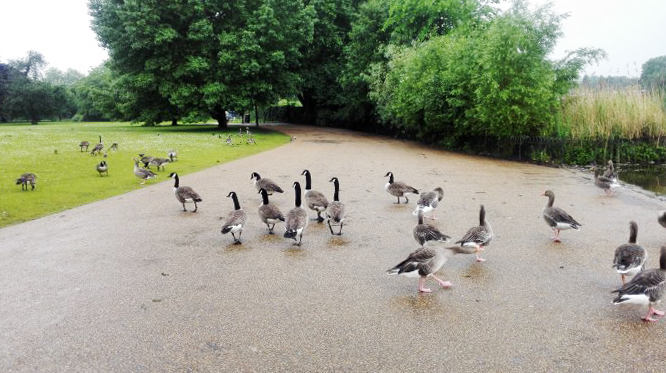
Geese in the park
After we wrenched ourselves from the playful ducks by the water, we headed to StudioRCA. This was the first exhibition opening we attended in London and it was for the artist [and past K11 Wuhan resident] Daniel Shanken’s video work. Viewing the work inside the glass-walled gallery, sitting before a backdrop of the Thames River and a setting sun was an especially beautiful experience. This was made more pronounced by the exhibition set up as the audience was separated from the work, locked away inside the gallery, by the glass walls. We ran into Alia Pathan, an artist who had done at Red Gate Residency.
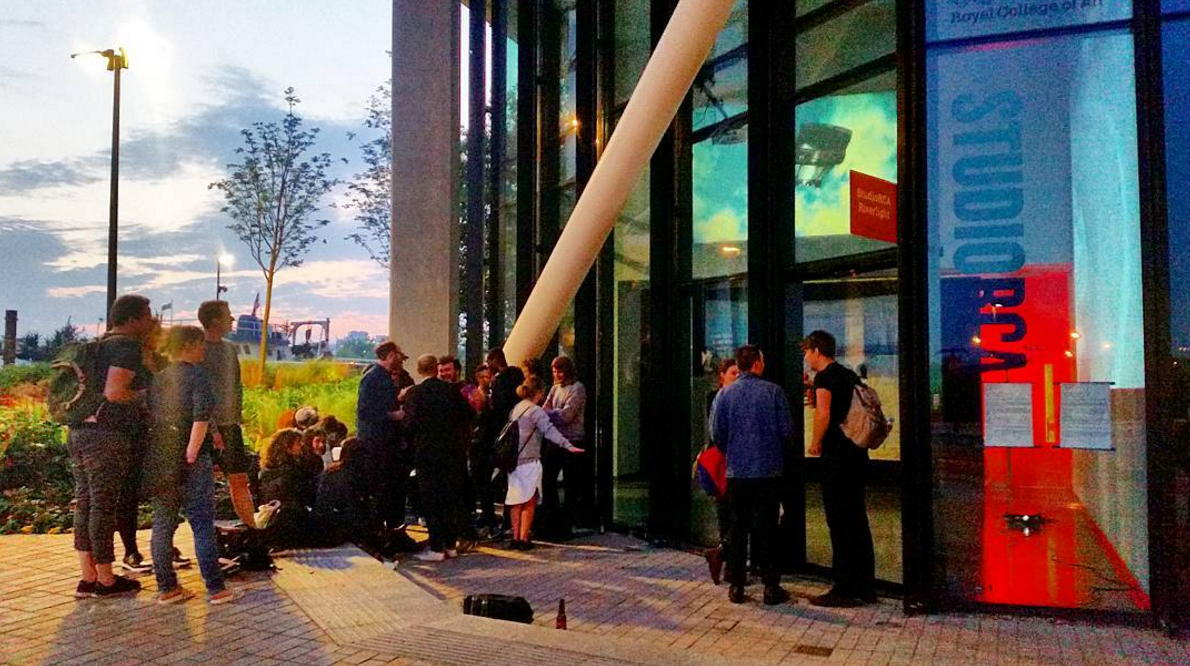
Opening reception + beer + snacks + art. Kind of felt like Beijing.
Day 3 - London
The weather was decent, so we wandered around Walthamstow, where a few families in the neighborhood held yard sales.
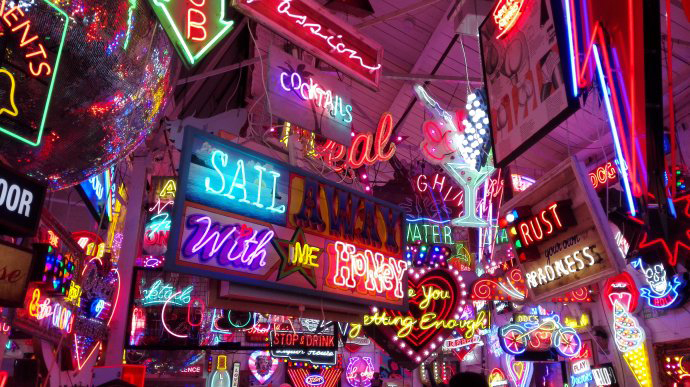
We stopped in God's Own Junkyard, an eclectic collection of neon sign.
We took the double-decker bus into the city center. Rehearsals for the Queen's birthday were happening on the steps outside of St Paul's Cathedral. We walked past the London Bridge strolling along the Thames, passing by Shakespeare's Globe Theater and stopping for fish & chips in the bustling Borough Market.
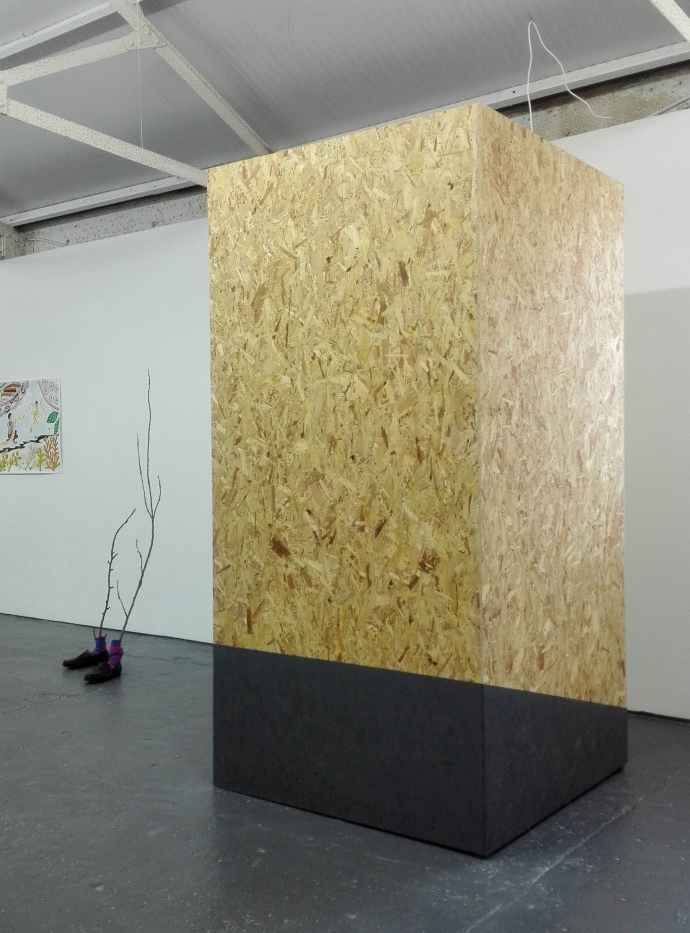 Peckham, in the South of London, has quite an interesting arts district and reminded me of 798 back in the day. At Bosse & Baume gallery, we caught another past Red Gate artist-in-residence, Nicole Vinokur’s group show. The works were quite conceptual, Nicole's installation was a large constructed box with a tiny peephole allowing viewers to glimpse colorful flowers.
Peckham, in the South of London, has quite an interesting arts district and reminded me of 798 back in the day. At Bosse & Baume gallery, we caught another past Red Gate artist-in-residence, Nicole Vinokur’s group show. The works were quite conceptual, Nicole's installation was a large constructed box with a tiny peephole allowing viewers to glimpse colorful flowers.
Then we went on to a group show of Latin American artists at South London Gallery. curated by Pablo Leon de la Barra, current curator at the Guggenheim Museum, and one of the jurors of the Davidoff Art Initiative. It's a beautiful gallery with an exquisite garden. There were many installations as well as a few political video and photo works, including work by previous Red Gate artist-in-residence Engel Leonardo. So nice to see old friends in new places! A punk band performed, the food was delicious, and there was plenty of to drink.
Pablo also curated the after party at White Cubicle Toilet Gallery, a roving pop0up art space hidden in the bathroom of a gay bar. It seems like openings are the same all over the world, always involving a group of people drinking, chatting, and having fun.

Engel Leonardo's "Plantano Power Bottom"
Day 4 - London
The V&A is by far the coolest museum I’ve ever been to. Now I think I really understand these two words: eclectic and dazzling. More antiques and artworks than I could even count! It's stunning. Nothing comparable in China comes to mind.

The plaster halls at the V&A
The V&A is not only marvelously massive in the scale of its history and collections, they also have an awesome team running the place. And their café is also excellent, and since the sun was out, we sat outside in the courtyard. We met with the V&A’s Residency Coordinator Laura Carderera and Shekou Learning and Interpretation Manager Sara Green. Laura is the only staff member working on the residency program in the V&A's entire 900-person team. Having this huge vault of artworks and cultural artifacts is definitely a draw for artists-in-residence at major museums, like George Shaw did during his time at the National Gallery. Sarah will be heading up the residency program for the new V&A in Shenzhen’s Shekou district.

V&A artist-in-residence Pauliina Pöllänen
It's easy to get lost in the V&A, each gallery leads to another marvelous one, I didn't even know where to start. There were countless rooms of the royal family's collection, as well as many precious antiques from China and elsewhere in Asia as reminders of the colonial empire's power and influence.
We walked through Regent's Park another one of London's huge beautiful green spaces. Ducklings and baby squirrels ran all around us, it was an adorable display of springtime. We then met up with Ming Lin and one of her friends for Indian food. It's almost as if London doesn't have any of its own culinary specialties, but it makes up for it in all its wonderful Indian, Italian, and Caribbean restaurants.
Day 5 - London
We started off the day by checking out the British Library, then attended a workshop at Art Catalyst titled “How to Speak.” This was an event organized by Ming Lin, recipient of the 2nd Crystal Ruth Bell Residency at Red Gate in 2015 and current China Residencies board member.
 At 4pm, we hurried off to Delfina Foundation and met with their artist-in-residence Emma Smith, who works in sound and performance. We just made it to her workshop, where she played a silent video of a performance streamed from the web, while dubbing over all the sound effects herself. This got the whole room laughing and comfortable. She then involved everyone in creating sound effects together in this very experimental and fun workshop. We talked to Residency and Program Manager Jane Scarth afterwards who told us that there are 6 artists-in-residence at a time who stay between two to three months. Not only does Jane work on everything to do with the residency program, she also works on research for exhibition curation.
At 4pm, we hurried off to Delfina Foundation and met with their artist-in-residence Emma Smith, who works in sound and performance. We just made it to her workshop, where she played a silent video of a performance streamed from the web, while dubbing over all the sound effects herself. This got the whole room laughing and comfortable. She then involved everyone in creating sound effects together in this very experimental and fun workshop. We talked to Residency and Program Manager Jane Scarth afterwards who told us that there are 6 artists-in-residence at a time who stay between two to three months. Not only does Jane work on everything to do with the residency program, she also works on research for exhibition curation.
We stepped outside and walked right past Big Ben and Buckingham Palace. Although I'd seen countless pictures, it's still stunning to see these buildings with my own two eyes. The architecture is really grandiose, and Big Ben chimed right on time at 6 pm.
 We then went to see the work of Andrew Sunderland, previous Red Gate resident, at Hackney’s LimboLimbo. Another former Red Gate artist Blanca Ulloa was also there, and we saw all kinds of crazy performances. The eccentrically decorated DIY space was overflowing with chaotic sound and video art -- it reminded me of a wilder Caochangdi.
We then went to see the work of Andrew Sunderland, previous Red Gate resident, at Hackney’s LimboLimbo. Another former Red Gate artist Blanca Ulloa was also there, and we saw all kinds of crazy performances. The eccentrically decorated DIY space was overflowing with chaotic sound and video art -- it reminded me of a wilder Caochangdi.
We then headed to a lovely dinner hosted by Blue Curry for a dozen of artist friends from the US, the Caribbean, Spain, and China, all in town for different projects. Everyone was so friendly and got along effortlessly, it was a welcome break from the standoffish Londoners we encountered at some of the other openings, who admired the works from afar but only spoke to those in the "in" crowd. At Blue's place, we talked until late at night and finally all headed our own ways at 2 am.
Day 6 - London
The previous days were pretty exhausting, so we took it easy and spent the afternoon ambling around different markets, and later ended up at Whitechapel Gallery. The gallery is spacious but quiet with a wide variety of work that can be enjoyed for long periods of time, and seems to have a large staff. The newly opened exhibitions were of Mary Heilmann and Keith Sonnier’s works. Whitechapel also does other programming as well: panels and discussions, workshops, book signings, and other publicly accessible and educational events. There are many things in common between modern art displayed in a historical chapel, and Red Gate Gallery that’s situated on watchtower of a Ming dynasty wall.
We cooked dinner at home and I took the time to write a few postcards.
Day 7 - London
We visited the Barbican Centre, a fascinating planned city-within-the-city, known for its much-criticized bulky brutalist architecture and cement buildings. We then wandered through the fantastic National Portrait Gallery, the first museum dedicated to portraiture. Next door, the National Art Gallery was filled with groups of schoolchildren and their teachers. I recognized many paintings from my art history textbooks, like works by Jan van Eyck, Hans Holbein the Younger, Da Vinci, Van Gogh and more. These museums are endless and overwhelming, with so much food for thought that it kinds of melts your brain. It's more than I could handle in one day.
We decided to try the UK's version of Chinese food in Soho, which included a strange combination of fried oily things and prawn toast, and some the most expensive noodle soup I've ever had. Not particularly authentic, but interesting nonetheless.
We continued on to Westminster University for a screening of Fan Popo's short documentary "Mama Rainbow" about China's LGBT youths and their mothers. The audience was captivated, and asked all kinds of questions about why he hadn't yet been arrested yet, and how he deals with attempts at being censored or otherwise repressed by the undemocratic regime. I got the sense that there was much righteous indignation about China's rampant human rights violations and an ardent desire to rescue us, as if all Chinese people live in a constant abyss of suffering. I feel that people outside of China have a pretty one-sided and prejudiced understanding of what's happening in China today.

Fan Popo speaking about his films
After the screening, we walked through Soho, where people gathered in the gay bars and in the streets to grieve in solidarity, giving speeches and dances in honor of the people killed in the shooting at a gay club in Orlando the day before. It's moments like these that make England strong.
Day 8 - London
I headed out to New Cross Gate first thing in the morning under a light rain for a studio visit with Alia Pathan, who came to Red Gate with support from the Red Mansion Foundation. We commiserated about how after paying rent for her apartment and studio, her oyster card and groceries, there isn't much left over. London is an expensive city, it's not easy being young there. People moving to Beijing face a similar situation, myself included, we're barely getting by in these big, crowded cities. We took the train from the edge of town towards the Slade School of Fine Art, for former Red Gate artist-in-residence Maud Cragie’s thesis exhibition. The entire school's students had work on display. The work was innovative and bold, and for the most part, very interesting. The main difference with the graduate shows at CAFA was that here, each artist could install works in their studio spaces as they see fit, instead of showing all the works in a gallery setting. It makes more sense here, and gives the students more space and freedom. Then we went to the nearby gallery Wellcome Collection, which has a show up about psychology and philosophy, and another of large video works. The works were interesting, London's gallery scene is really solid.
The former Red Gate crew and I headed to a pub. People here drink every day, sometimes starting around noon. It's really astonishing how much the British like to drink, everyone I met suggested we "go for a pint."
Day 9 - London
It goes without saying that the British Museum is also excellent, with a stunning glass ceiling over the main atrium. My favorite part was the Egyptian wing, complete with intricately carved stone frescos, precious antiques and daily artifacts, and of course, mummies. Unfortunately, the Chinese collections were being re-installed, so I wasn't able to check them out. The former British Empire had the foresight to grab everything it could save for the land itself, but it took countless wars and sacrifices to bring back these glorious trophies. Since ancient times, everything grand and majestic was built on the backs of countless suffering, every advance paved in blood, sweat, and tears.
I met up with Nicole Vinokur again to wander around Camden Market, which was expensive and just like tourist spots you see in China. We walked into shops that sold funky clothes to wear to raves and BDSM sex clubs, it all looked a little like an art installation. We continued our peaceful stroll through Camden's flower markets, chatting about art and London's creative scene.
Day 10 - London
This trip to the UK felt like a great catch-up with friends from Beijing -- I met up with another former resident, Evelyn O'Connor, and we reminisced about our memories from China. The weather wasn't cooperating. Rain started pouring again from the dark and gloomy sky. We arrived at Southbank Centre to meet with Rachel Harris and Georgia Ward, who gave us the grand tour. The space includes a public areas where everyone can enter as they please, and use the space it for pretty much anything from conferences and meetings, panels and discussions, and even performances. Dancers rehearsed in the entryway, and there’s a new performance in the theater basically every day. Outside, wide open areas are covered in graffiti and visually very striking. Across the way, the new Southbank is expanding rapidly and will include and support more spaces for the arts.

Posters from Meltdown, a festival series curated by artists like David Bowie, Patti Smith, and Yoko Ono
Around 4pm we went to meet another one of China Residencies's board members, curator Rachel Marsden, along with several curators and artists from CFCCA in Manchester before our meeting with the organizers of the Chinese Visual Festival, James Mudge and Dr. Victor Fan. After Xi met Cameron, relations between the UK and China became more intimate, and large amounts of money was thrown into cultural exchange, and China Visual Festival is one of the results of this investment into art exhibitions and media events.
We had dinner with Rachel then made our way to Trapeze Bar for the London Vogue Ball, where Kira's friend Sydney UltraOmni was DJing. All the dancers were amazingly awesome, it was so exciting to be there.
At 9 pm we went to the Tate Modern’s opening reception for the inauguration of the Tate’s Switch House expansion. The two buildings, old and new, are connected with an open corridor and museum shop. The opening festivities went on for close to a week, with different openings for patrons, artists, museum staff and so on, with a packed schedule of performances and artist interventions, and lots of champagne. We watched Benjamin Clementine's beautiful concert from the bridge overlooking the turbine hall, and took the steps all the way to the 10th floor of the new building since the elevators were overcrowded. The view of the brightly lit London skyline was well worth the climb.

Overlooking Ai Weiwei's sculpture in the Turbine Hall during the opening
Day 11 - London
We did a Q&A in Kensington Park to give people in the UK a better sense of artist residencies, and the current state of China’s art scene. Our initial plan to have a meet up in the park turned into an online Q&A since it was still raining on and off. Except for a few questions about residencies, most of the questions were about the Internet. There were also some strange ones that came up about whether or not people can drink on the street in China.
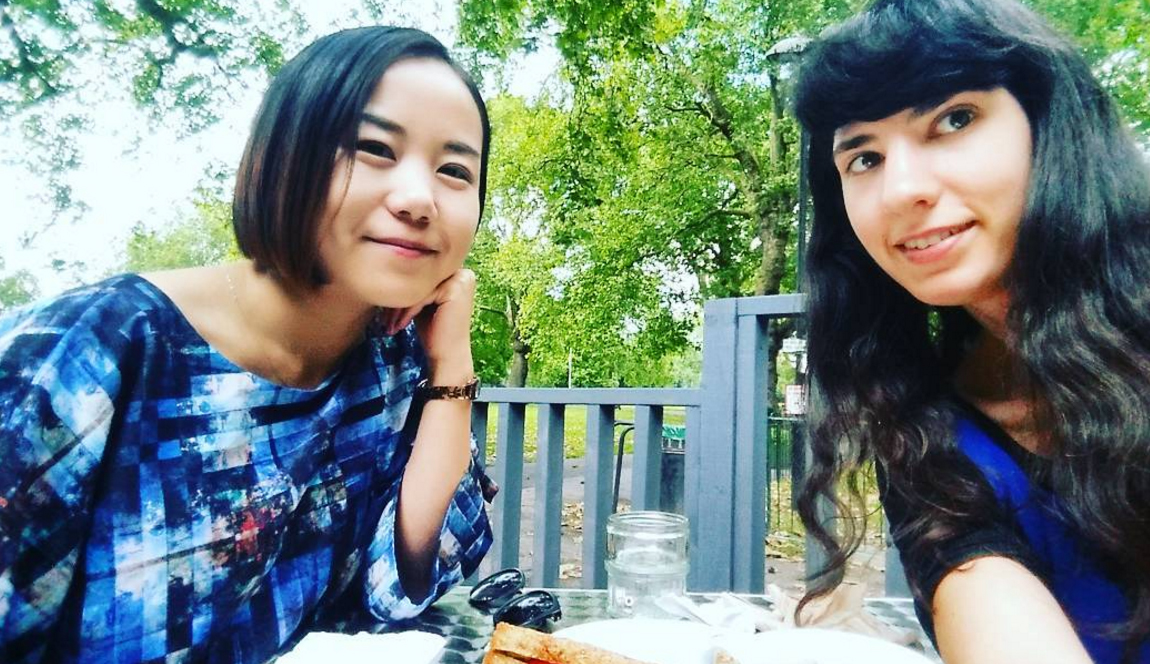
Xinru & Kira's online Q&A
At 5pm, we went to Gasworks and met up with curator and residency director Alessio Antoniolli and got a better sense of Gasworks as well as Triangle Network. Gasworks was established in 1994 with the support of the British Council and other organizations, and helped to facilitate much of the cultural exchange occurring between the UK and other nations. It was great to hear that they’re excited to work with Red Gate.
We then went for an opening at The House of St. Barnabas, a really interesting charity organization, as well as an exclusive not-for-profit member’s club. Members donate their club dues to fund job training for homeless people, including working in the gallery and with artists. The space is huge, with many different rooms featuring a very international group of artists, including artists from China and Singapore. There were also live music and dance performances, and new media installations in beautiful chapel. There was a line forming around the block when we left!
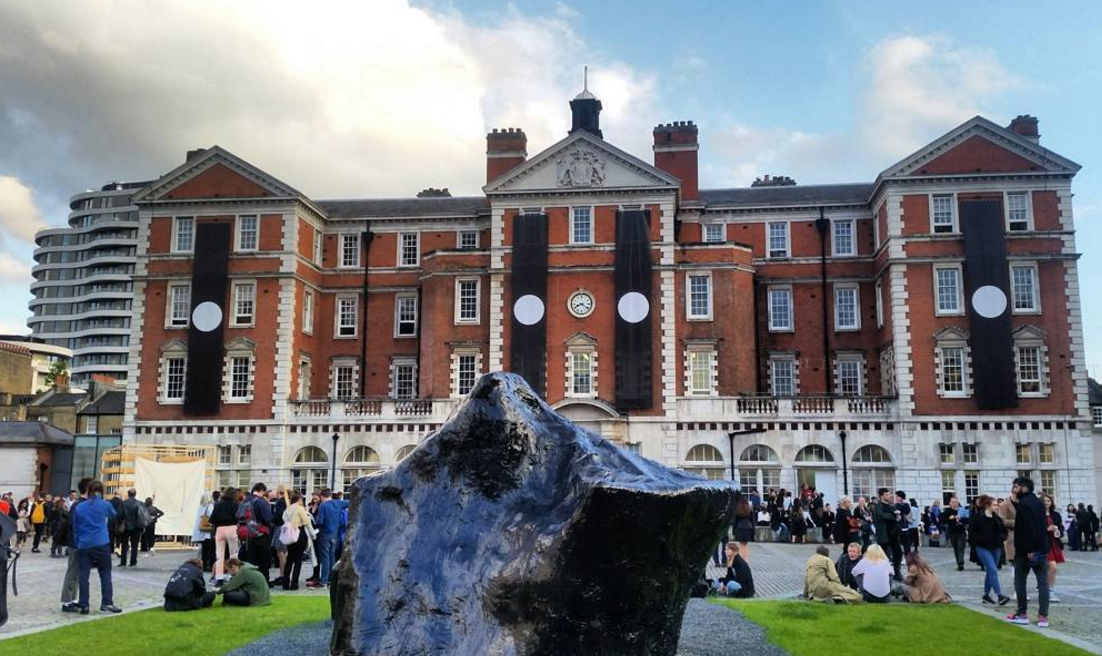
We stopped by the Chelsea Undergraduate Show.
Again, impressed by all the work.
Day 12-13 - London
 The National Natural History Museum was filled with children fascinated by the fantastic bird, insect, and mineral specimens, enormous dinosaur skeletons, and science dioramas. I climbed inside the "Earth" in the geology wing, so many people engaged with the participatory exhibits, interacting with the installations to learn about earthquakes and volcanoes. After spending the morning at the museum, we met up for a proper english breakfast with Zara Arshad. She’s not only a curator but also a research assistant at V&A’s Design, Architecture and Digital Department, as well as the founder of Design China. We chatted about Hangzhou and the upcoming projects around design she’s been working on, as well as the upcoming V&A show around future technology. It's interesting to learn that exhibitions take at least two years of planning. We walked back over to the V&A to find the Rapid Response design collection Zara had been telling us about, but it was also closed for installing, so we got lost in the myriad of sumptuous rooms again.
The National Natural History Museum was filled with children fascinated by the fantastic bird, insect, and mineral specimens, enormous dinosaur skeletons, and science dioramas. I climbed inside the "Earth" in the geology wing, so many people engaged with the participatory exhibits, interacting with the installations to learn about earthquakes and volcanoes. After spending the morning at the museum, we met up for a proper english breakfast with Zara Arshad. She’s not only a curator but also a research assistant at V&A’s Design, Architecture and Digital Department, as well as the founder of Design China. We chatted about Hangzhou and the upcoming projects around design she’s been working on, as well as the upcoming V&A show around future technology. It's interesting to learn that exhibitions take at least two years of planning. We walked back over to the V&A to find the Rapid Response design collection Zara had been telling us about, but it was also closed for installing, so we got lost in the myriad of sumptuous rooms again.
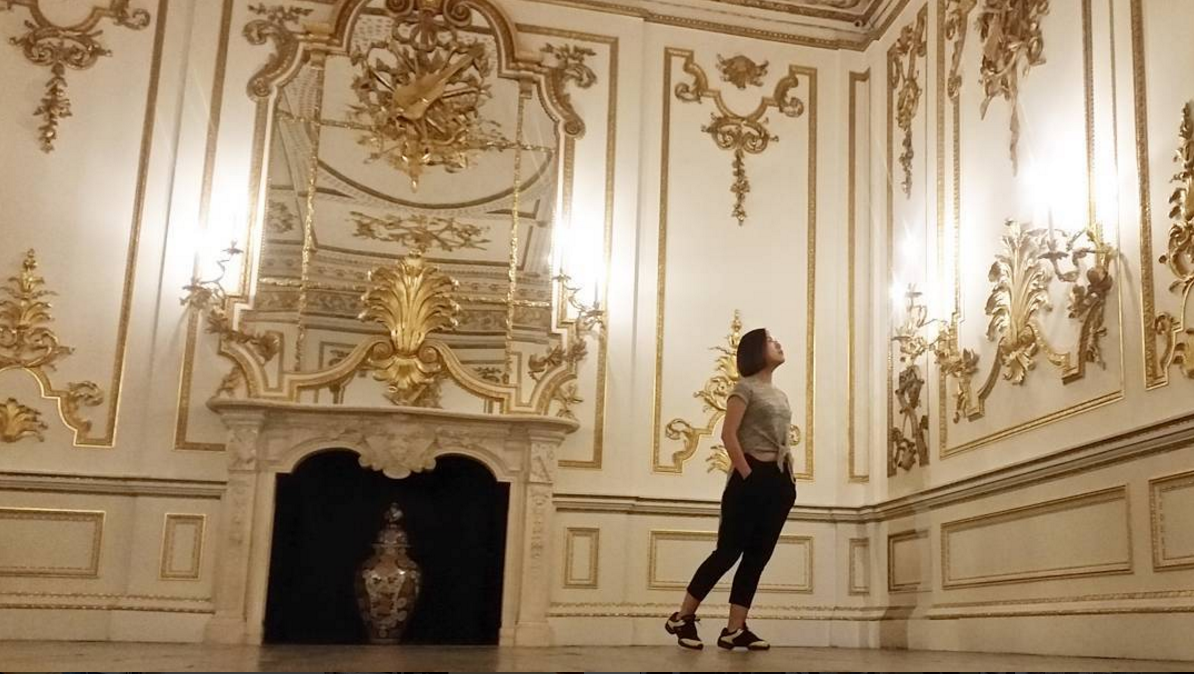
Xinru in the V&A's music room
Afterwards we stopped by Camden Art Centre again for the opening of the “Making & Unmaking” show. The curator Duro Olowu is a renowned fashion designer and invited over 60 artists from all over the world who make work about fashion, textile, and craft. Camden Art Centre also has a residency program that is co-organized with Slade School of Fine Art, where students can spend some time during the summer as artists-in-residence. The garden was filled with a well-dressed art crowd, where people don't really feel comfortable chatting to others without an introduction. It felt a bit more formal than openings in Beijing, many of the artists were at the opening and stayed around to chat. We also met the very fashionable Michael Xufu Wang of Beijing's MWoods, a newly opened private museum, which is also hoping to start a residency.

Camden Art Centre's garden during the opening
The next day we came back to Camden for an artist talk between Duro Olowu and Glenn Ligon. We hurriedly headed off to board the train to Manchester. I watched the changing landscapes out the window while Kira caught up on the 200 unread emails that had piled up over the past two weeks (besides running China Residencies, she also works as documentary film producer.) In June, she had just recruited ten awesome new board members with all different kinds of skillsets from all over the world. I really admire Kira's dedication in running this organization.
It was still raining when we got to Manchester, which felt a lot quieter and less crowded than, but with a huge Chinese expat community. We made our way to Islington Mill, an art space in a former cotton mill in the neighboring town of Salford. The Mill is also home to an artist-run Bed and Breakfast, we slept in dorm bunkbeds sharing a room with young artists Racheal Crowther and Dan Szor working on their show, "neither happy nor an hour" at Caustic Coastal. They walked us into town, the city felt very empty after the streets had been closed off for Manchester Day. We end the evening by having dinner with China Residencies board member, An Xiao Mina who was in town for a conference.
Day 14 - Manchester
Met with the Mill’s friendly founders, the artists Bill Campbell and Maurice Carlin. The space was started in 1999 when the artists gathered loans and collectively managed buy the 10-story building and renovated it into artist studios. There have been over 5,000 artists and creators coming through the space since its founding.
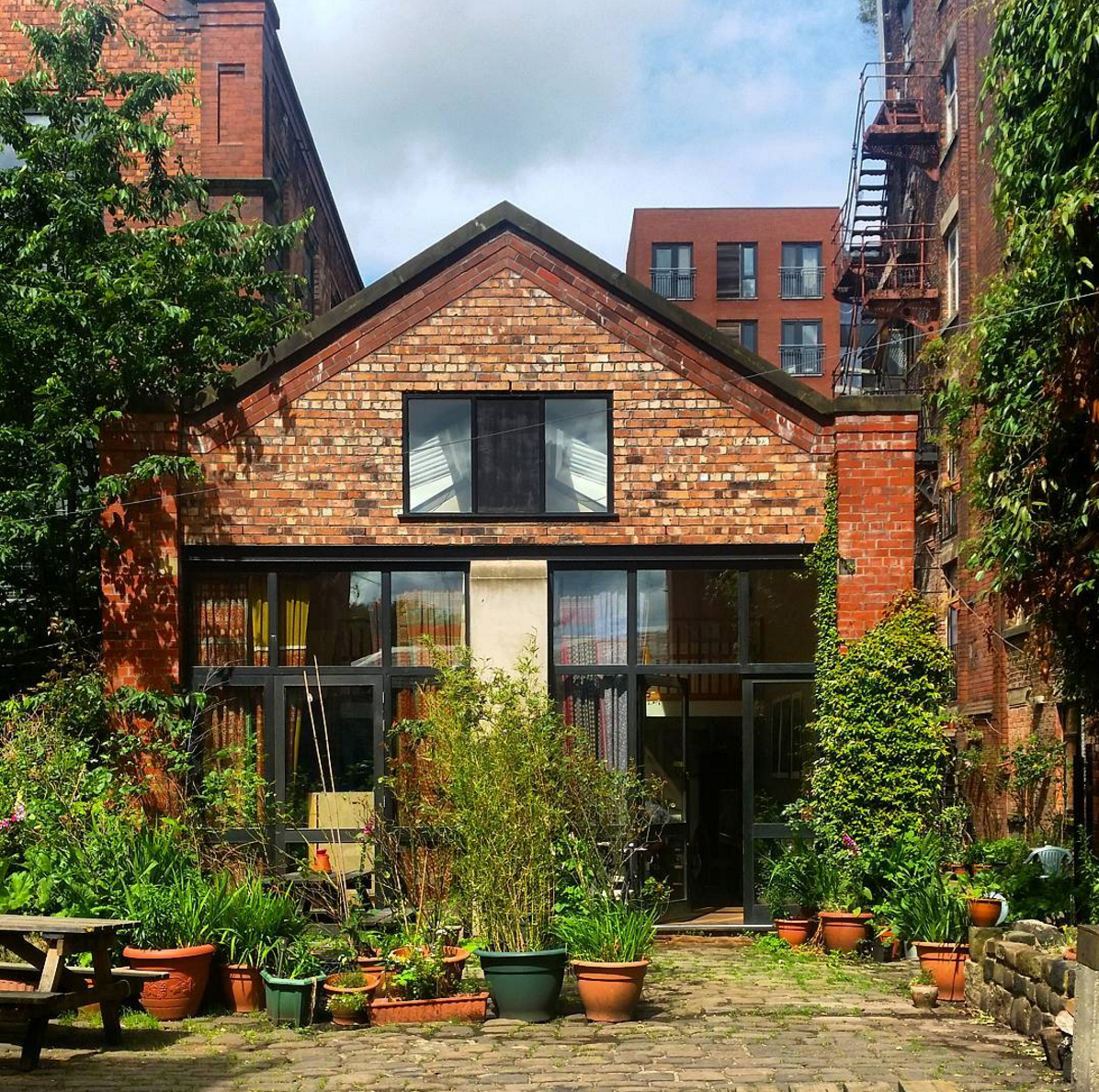
Islington Mill
We took a cab to Whitworth Gallery, where An Xiao Mina was to give a talk at the Picturing the Social conference later in the afternoon. We met with journalist and PhD researcher Linda Pittwood who writes about gender and feminism in art. We had an in-depth conversation about women artists in China and I invited her to do a residency with us so she could gather more material for her PhD.
The Whitworth Art Gallery was really cool, with a beautiful collection of textile works. The ground floor exhibitions were curated by artists around the themes of mourning and sleeping.
An Xiao's talk was titled “Diversity on the Internet: A Goat Thing”, where she gave a lively and fascinating presentation about how internet memes don't just revolve around cats, since different cultures use different symbols to express themselves. For example, in Latin America, it's goats.

Day 15 - Manchester

A day of mostly catching up on work on our computers. I had quite a few things to prepare for when I get back to China: WeChat invitations for our open studio days, and the plan for our July residency.
Bill and Maury are friends with Dean Brierley, a young and driven art school grad who founded Caustic Coastal by renovating the warehouse next door to create studio and gallery space. He took us for a tour, the space is absolutely enormous, with room for up to 10 studios.
Around 2 pm we took a break and trekked from the West side of town to the East, where we found a huge, temple-sized Chinese food market. Dumpling wrappers, pork, green onion, mushrooms, Bok choy, eggs, chives -- we found everything! We walked back and got ready to chop everything up, then realized we didn’t have the right knives. What a difficult task that was! We invited An Xiao to come by and share some this big batch of dumplings with us, and saved the rest for our talk the next day.
Day 16 - Manchester
I spent the earlier part of the day walking around town on my own, wandering into the Manchester Cathedral. I was a little hesitant to go into such an imposing building, but the church attendant was welcoming, the choir was singing and someone played the organ. The large, colorful stained glass inside was marvelous. As I made my way back through central Manchester, all the streets will filled with people trying to woo over voters and shift the polls in light of the upcoming Brexit referendum.
I mailed a postcard full of love and sunlight to the Red Gate team back in Beijing, and came back to the Mill for our presentation and Q&A. I was pretty nervous but thankfully, said nothing silly. Most of the artist in the crowd of about 15 were younger artists, and only Maury had ever gone to China before for a residency at Organhaus. They had pretty abstract ideas about China but all seemed interested to give going there a try, and all enjoyed the dumplings.

Xinru talking about Red Gate at Islington Mill
Maury and Bill then took us on a full tour of the Mill. The upper floors were worn down from years of disuse, but they are currently fundraising to renovate the Mill’s top floors into eight brand new artist and maker residence spaces. They're both such honest and lovely people who've dedicated their lives to helping artists.
Day 17 - Manchester
Norwegian artist Lotte Karlsen, founder of the collective Alexandra Arts which runs an international residency program for female artists, Pankhurst in the Park, inspired by Alexandra Park's connection to the Suffrage Movement leader Emmeline Pankhurst. Lotte led us around the park and the adorable little building that functions as a residency space for feminist artists and place for public events. The exhibition area is outdoors, in an extremely lush clearing. It's a great idea to go "back to nature", it really felt like a whole other universe inside the city. Establishing a residency program here is such a genius idea! I really admire all the work Lotte has done in establishing and running Alexandra Arts. She’s persevered for nearly ten years, even though she had almost no support or recognition at the start.

Lotte Karlen of Alexandra Arts showing us the exhibition space
We had a picnic on the grass in Piccadilly Gardens and called Emma in Taiwan, it was great to hear her voice and catch up, just like old times. We then headed to met up with David Hancock of Paper Gallery, a tiny artist-run gallery with a residency program for emerging artists making work with paper. Afterwards, we hopped over to the opening reception for Taiwanese-born Londonite and artist-in-residence Yu Chen Wang at the CFCCA(Centre for Chinese Contemporary Art). Her performance piece, "The Island", had to do with the politics and hegemony of islands.
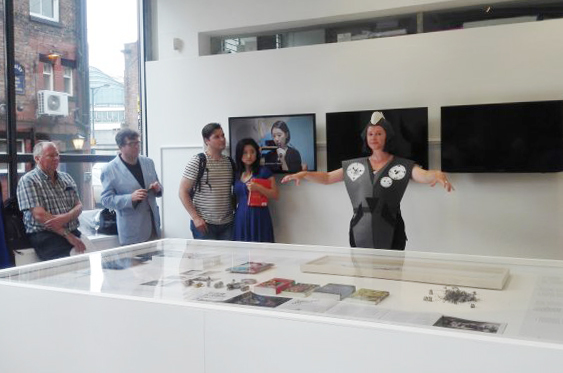
Yu Chen Wang's performance "The Island"
Since arriving to London, the topic of voting permeated all of our discussions, no matter where we went. Everyone around us, being artists, all voted to “remain”. I don’t think I got a full picture of non-artist UK citizens whose perspectives lay outside of this circle.
Day 18 - Manchester & Edinburgh & Arbroath
We woke up to the news of Brexit. Sadness pervaded the air all through the Mill. We sat around the breakfast table in a gloomy stupor. The concept of direct democracy is pretty strange to me. What's even more confusing to me is that everyone we had met so far all voted to remain, yet Britain will still leave the E.U.
We went on to meet up with Hannah Hartley, operations manager at CFCCA, and told each other about our respective residency projects. Yu Chen Wang then made a delicious Chinese breakfast as part of her performance to celebrate CFCCA's 30th anniversary. I’m eager for the opportunity to meet her again. CFCCA's curator Ying Tan showed us the residency lofted living quarters, tucked away up a ladder above the studio attached to the art centre. We then ran to the train station to catch our to Edinburgh. We switched trains in Preston, and I bought Kira a chocolate cupcake, hoping that the sweetness would lift a heavy heart.
We arrived in Edinburgh, with an hour and a half connection before our next train to Arbroath. We met up with Patricia Healy McMeans, a PhD researcher at the Edinburgh College of Art focused on artist residency programs in Scotland. She took us on a whirlwind tour down the Royal Mile and through winding alleys to a great view of Edinburgh Castle.

Edinburgh Castle
We hopped back on the train to arrive at Hospitalfield just in time for dinner. We were treated to a delicious home cooked meal in the wonderful company of artists Lubaina Himid, Ingrid Pollard, and Rebecca Chesney, as well as the residency director Lucy Byatt and manager Laura Simpson. The windows looked out on green fields and the vast blue ocean, as far as the eye can see. After dinner, we chatted with Lucy and Laura about the residency. I had to concentrate extra hard to try to understand everyone’s accents, I felt like my brain failed me millions of times.
Day 19 - Arbroath, Scotland
Since reading Jane Eyre and Wuthering Heights as a child, I’ve always dreamed of staying in a castle by the sea. It was overcast when we woke up in the morning, but I rose with a soaring feeling.

Hospitalfield
The lightest drizzle floated down on the castle’s expansive garden, complete with tidily trimmed lawns and beautiful flowers. The garden path leads to a greenhouse, and the artist studios are tucked away in former stables behind the greenhouse.
Lubaina Himid is one of the artists-in-residence and she invited several artist friends to take part in the most generous and lovely ways. Rebecca Chesney is an artist who bases her practice in biological and environmental research. She led a workshop inviting us to explore the area’s plant and animal species, and led a group of us into the garden to catch and identify bees.

The rain picked up, but nobody minded. Everyone was well prepared and dressed for the weather in raincoats and umbrellas. I tried to stay dry by holding a sheet of paper above my head to no avail, ten seconds later I retreated to the greenhouse. My hair hadn’t been dry for a minute in the entire time I’d been in Scotland.
The Open Weekend brought all kinds of people to visit beyond the residents and residency staff, people of all generations, including elderly couples and children, all came together for these lively events. Alec, a volunteer, took us on a fascinating tour of the castle. There’s a story behind each and every carpet, wallpaper, moulding, and oil painting. Hospital Field’s history spans over 700 years. In 1840, Patrick Allan-Fraser, returned to Arbroath in Scotland to marry into his bride’s family and transformed the hospital into a place for the arts.

From that time onwards, the Frasers started collecting artworks, and hosted artist friends, which was in sorts an early version of an artist residency, until Patrick Fraser passed away in 1890. Then, after a few years of inactivity, the art school and residency was founded in close collaborations with art schools in Edinburgh, Glasgow, Dundee and Aberdeen. To this day, Hospital Field is a charitable organization dedicated to serving artists.
Tamara Henderson made an installation out of drinks. She is a Canadian artist who worked with a collaborator to create a visually striking and delicious fountain filled with beet and ginger juice.

Afterwards, Ingrid Pollard gave an artist talk about her photography.
A friendly artist from the residency who worked for 40 years in printmaking kindly showed me around the print studio’s very cool printing equipment. He was also a devout Christian. Later that evening, Kira and I discussed race and dialectics. She shared her thoughts on how racial discrimination is due to ethnic groups in power develop longstanding assumptions that they are somehow superior to others.
After dinner, a group of us went for a walk by the seaside. We passed through fields of tall grass until we reached the water. The sea breeze and strong smell of kelp hit head-on, and as we walked, the clouds fluctuated endlessly. The sky and the sea were of one color.

Scotland was beautiful and peaceful.
We walked along the coast, jumping over rivulets, and didn’t turn back until we lost sight of everyone else. We talked as we walked, and I learned about the work Rebecca made in 2012 called “I'm blue, you're yellow.” She planted two vast fields in a public park, one with blue flowers and the other with yellow flowers. The fields change over time, as does the work’s appearance -- it’s a lovely artwork with an adorable title.
I chatted about residencies with Laura, who runs Hospital Field’s residency program. Right now, Hospital Field has the space to host around 10 artists at a time. Besides Laura and Lucy, there are often university students working as interns and fellows to provide program assistance. They have one deadline per year [November 28 for next year] for their three scheduled residency sessions, but outside of these sessions, few artists apply individually, so the residency isn’t too busy most of the time -- unlike Red Gate, which is always running at full steam. They also already have a very detailed plan for the residency’s future, including expanding existing buildings to create more studios and making repairs to the castle.

We returned to the castle, grabbed red wine and glasses, and climbed the spiral staircase to reach the top of the south tower. It was spectacular to see the castle from such a high vantage point, and it didn’t get dark until after 11 pm.
Day 20 - Arbroath, Scotland
We ate breakfast and packed our bags.
Ingrid Pollard lead us through the steps of making camera obscuras, and we stepped outside to look at our surroundings through these new lenses. Ingrid invited us to describe what we saw through our lenses to each other, so I described the scenery to Kira who wrote down and illustrated my descriptions: “green grass, blue skies, a dog rolling in the grass, a girl in a red dress doing cartwheels, the sun’s come out again, shining light on the whole garden….”
After a delicious lunch, we said farewell to everyone. I gave small gifts I brought from China to Lucy, Laura, Molly, Alec, and Rebecca. We left Arbroath by train, it took over six hours to get back to London. I alternated between being sad about leaving after just a taste, and reflecting on our entire journey across the UK. In London, we met up with Ian Yang from Dutch Culture’s China desk for the last dinner of the trip.
Day 21 - London, Heathrow Airport
These past 20 days were magical and enriching. The Queen’s birthday, the Tate Modern’s expansion, Brexit -- it seems as if we experience quite a few major events. I’m grateful to have met so many notable artists and to have heard and learned so many things on my first trip away from my homeland. I’m also grateful for Kira’s considerate guidance and expertise, and to have had the chance to get to know all the people we encountered along the way. This trip marks a very special time in my life.
- All good things must come to an end.
- Flying from London to Beijing.
- Bye, UK.
Xinru wrote this diary in Chinese in July 2017. We'd like to extend our thanks to Transnational Dialogues for supporting this initiative, and to all the residencies, art spaces, and gracious hosts who helped shape this trip.
Translation by Fei Liu, photographs by Hu Xinru, Kira Simon-Kennedy & Ross Fraser McLean.
